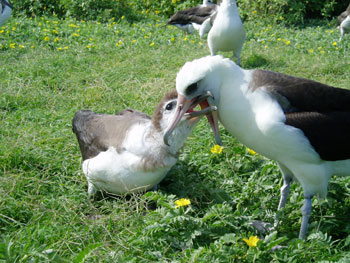|
You
are here: /main/research
expeditions/June-July
2006/ Day 15
March of the Albatross--In the Remotest Place on Earth, Love Finds the Way
Paulo Maurin, University of Hawaii

A young and inquisitive Laysan Albatross chick. Photo: Paulo Maurin
At a first glance, anyone would be hard-pressed to find any similarities between the Laysan Albatross and
the Emperor Penguin. Hawai`i versus Antarctica. The first one nests in warm tropical islands, while the
second one incubates the eggs in the coldest place on Earth. Albatross spend much of their lives on air,
even sleeping mid-air, while penguins cannot even fly. To raise the chicks and mate, one finds sand, while
the other needs ice. And these two magnificent birds do not ever meet.
But both share a story. It’s a story of love. It’s a story of survival. And is a story of the grave
threats both face. Although albatrosses are ill-equipped for walking, they perform annual marches in the
skies. Both penguins and albatross share a diet of fish. Both find remote places to raise their young.
Both of them place their eggs on the surface. And this surface needs to be far from civilization.
While these penguins are called Emperor, the Laysan Albatross are equally majestic. With a wingspan of
eight feet, their domain rivals in size the vast expanses that Roman Caesars ruled over.

A parent
feeds a hungry albatross chick on Kure Atoll. Photo: Claire Johnson/NOAA
Mating and raising a young Laysan Albatross chick is a perilous endeavor in which, just like the Emperor
Penguin, both parents alternate in Magellan-like voyages to find their place of birth. The Laysan
Albatross found in the Hawaiian atolls regularly fly as far as thousands of miles to the coasts of
Alaska and California to feed. When caring for a chick, parents forage for food, and then return to
the site where the chick hungrily awaits. The other parent has to then search for food. As it is true
with the Emperor Penguin, if either parent dies, so does the chick, as a single parent cannot properly
provide for the young one. And Laysan Albatross are dedicated ones, as they mate for life.
Both chicks, one fuzzy and one chubby, start practicing for their own march a few months after hatching.
The penguin chicks start with small, clumsy walks around their area, and they end up flat on the ground
many times. As the albatross chicks near fledging, they start to energetically flap their wings into
the air, converting the fat reserves on their chest into powerful muscles that will power their wings
over their long migration. They will lift themselves momentarily, only to return back to the ground
in a decisively un-royal manner. But each successive attempt brings added mastery of self-propulsion
for both. And after many small walks and mini-flights, one day they decide to embark in a great voyage,
one that will take them to far places. For once penguins and albatross leave their place of birth, they
won’t return for several years. Both have site-fidelity, eventually coming back to their place of birth,
in an annual ritual of love that produces life.

Another day at the beach for a couple of Laysan Albatross. Photo: Paulo Maurin
But love faces great obstacles, with common threats to both animals. Overfishing of the world’s oceans to
feed us is making them tragic casualties and their food sources dwindle. And there are other, even more
sinister, threats to their life. Two global threats, which we seem incapable of stopping. Both of these
threats come from the same source deep within the earth: petroleum. The burning of fossil fuels is a
culprit in climate change which, among other challenges, is melting the ice in the South Pole that is
critical to the Emperor Penguin’s survival. And plastics, another end product of petroleum, are
threatening the albatross at an equal magnitude, as they ingest it in a myriad of forms floating
adrift in the ocean, condemning many of them to a painful death.

Plastic items found inside a dead albatross chick. Photo: Paulo Maurin
And in a somberly real way, we are indeed unable to stop either one of these threats now try as we might.
Even if we give up using fossil fuels tomorrow, the effects of their burning would still be felt for
decades. If we stopped using plastics today, the loose pieces would litter the ocean for many, many
years to come. While on Green Island at Kure Atoll, we had a first-hand experience of how plastics
are killing the Laysan Albatross. A chick that was alive during our first morning walk was found
dead upon our midday return. When we examined it, we found its stomach full of plastics, one of
which pierced the stomach and caused it to die. The bolus of every single albatross on Kure contains
plastics, without exception. There are ten thousand chicks on this island alone. Maybe the albatross,
like their far-removed relatives on Antarctica, need their own documentary movie for us to become
aware of their plight, and their own march.
|